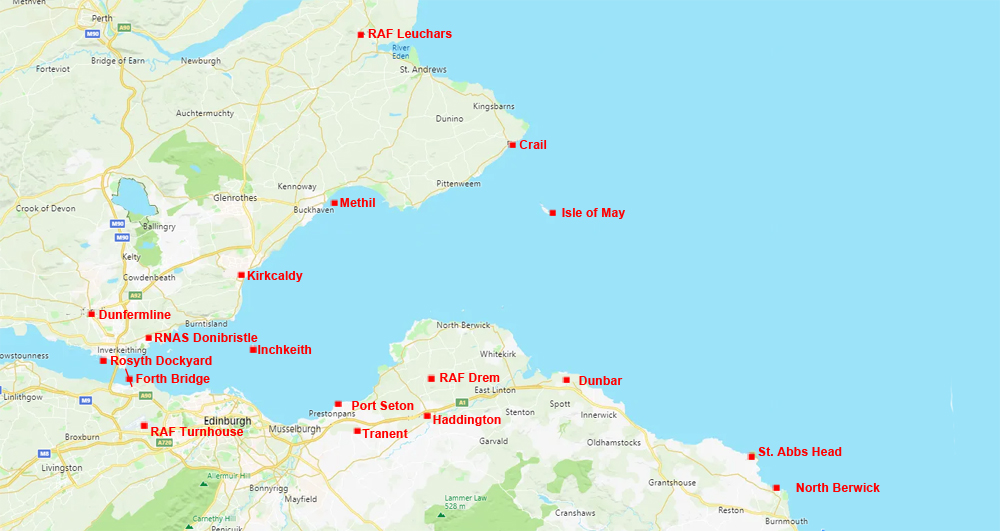First Air Raid of WWII – 32
Which RAF squadron shot down the first enemy plane of WWII?
| < 31 Poehle rescued | Δ Index | 33 attack on HMS Mohawk > |

The log of HMS Jervis states that 602 had shot down Pohle’s Ju88 eight minutes after Storp’s aircraft splashed into the waters of the Forth. This is the narrowest margin when examining the evidence of whether it had been 602 or 603 that had shot down the first enemy aircraft of WWII.
George Pinkerton’s Combat Report increased the margin to 15 minutes. The fact that Gifford had landed back at Turnhouse at 14.55 followed by Macdonald and Robertson at 15.00 also provides further confirmation which can be supported by those on the ground at Turnhouse. On landing Gifford completed his combat report stating the time of his attack as being 14.45. By December 1941, the matter was still in some dispute and Count Stevens, by then a wing commander, asked Air Intelligence for a ruling. On 28 December 1941. Air Intelligence replied:
. . . from this record you will see the first aircraft to be destroyed was by 603 Squadron at 14.45 hours on 16th October 1939 and the second by 602 Squadron at 15.00 hours on 16th October 1939. As these two were the first enemy aircraft destroyed by Fighter Command during the present war it clearly gives the honour of the first blood to 603 Squadron.
Despite this ruling the argument rumbled on. By the end of 1941 the matter had been referred to Fighter Command who gave the following response on 24 January 1942:
CLAIMS OF 602 AND 603 SQUADRONS REF DESTRUCTION OF FIRST ENEMY AIRCRAFT.
With reference to the above subject, it has now been established that the first enemy aircraft to be destroyed by Fighter Command was shot down by 603 Squadron at 14.45 hours on the 16th October 1939. 602 Squadron destroyed an enemy aircraft at 15.00 hours on the same day.
603 Squadron therefore has the honour of destroying the first enemy aircraft during the war: Copies of the Combat Reports arc enclosed.
The basis for the decision was the records compiled immediately after the event by pilots and trained ground observers. The subsequent analysis by Air Intelligence gave them no other option but to conclude that the first victory was Patsy Gifford’s and the other 603 pilots involved. Sadly, by that time he was dead.
Meanwhile, at the Coastal Command base of RAF Leuchars, 30 miles to the north-east, the Spitfires of Green Section of 602 Squadron were being refuelled after their abortive patrol towards Peterhead. Unaware that there was an air raid over the Edinburgh area. Douglas Farquhar wandered over to the mess to find out what was going on. He came rushing back to his two colleagues and announced: ‘For Christ’s sake get a move on, those aren’t Blenheims they’re ruddy German!’ The three German aircraft the pilots of 602 Squadron had spotted were in fact the fourth and final wave of Ju88s which had drifted a considerable distance north and were now heading south-west towards the target.
Air Vice-Marshal Richard Saul at 13 Group Fighter Command HQ in Newcastle kept Fighter Command HQ at Bentley Priory updated and at 14.45 he informed Air Chief Marshal Hugh Dowding, C-in-C of Fighter Command that he ‘. . . had Tally Ho from four sections’.
602 Squadron continued to be as involved in the action as 603. Flight Lieutenant Dunlop Urie intercepted a Ju88 off Kirkcaldy around 15.00 hours which he pursued on a south-easterly heading over the river towards North Berwick to St Abbs head and finally off the coast of Eyemouth where he discontinued the chase and returned to airspace over East Lothian. According to Urie, during the pursuit:
. . . Two Spitfires of 603 Squadron joined us and also had a go. When we reached St Abbs Head he was still flying on one engine and I decided there was no more we could do. He had been shot at by five fighters and I would be very surprised if he would cross the North Sea. Undoubtedly if we had closed to 200 yards he would have been destroyed. This was with hindsight. Our orders were very clear and given many times over.
Dunlop Urie highlights a problem experienced by many fighter pilots during the early aerial battles. Gun harmonisation at 400 yards was ineffective and Pat Gifford was one of many who sought to have the guns of 603 re-harmonised to 250 yards, a significantly more effective range. Had the guns been harmonised to 250 yards prior to 16 October, 602 and 603 Squadrons could have achieved greater success.
| < 31 Poehle rescued | Δ Index | 33 attack on HMS Mohawk > |
top of page
